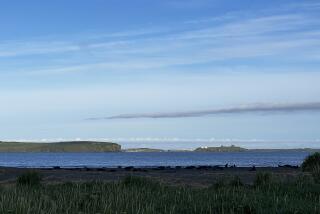Sailors on San Clemente Island face new adversary: deer mice
Navy says rodent population down after rains last winter led to spike in numbers
- Share via
SAN DIEGO — Sailors on San Clemente Island, home to a Navy air field and the service’s only ship-to-shore live firing range, are fending off a booming mouse population that has found its way into island work and living spaces, a Navy official said.
According to a tip sent to the San Diego Union-Tribune on Saturday, sailors are catching several mice per day in their rooms, and the critters have scampered across sailors as they sleep.
The tipster attached a photo of four mice caught in glue traps, which they said represented just a one-day haul.
Though the Navy did not confirm the account of mice running across sleeping sailors or that the photo was taken on the island, a spokeswoman said in a statement that winter rains led to more mice this year and that public works on the island were treating spaces for the rodents.
“The chain of command is fully aware and engaged,” said Helen Haase, a spokeswoman for Naval Base Coronado, which is in charge of the island. “We will continue to treat any maintenance issues of facilities to prevent mice accessing human spaces.”
San Clemente Island is part of the eight-island chain just off the Southern California coast. The island, about 70 miles west of La Jolla, is owned by the U.S. Navy and is home to several species of unique plants and animals.
It’s also home to 130 to 300 Navy personnel, a population that fluctuates depending on the Navy’s mission, Haase said. It can increase to 2,000 people at times.
Haase said environmental concerns limit what officials can do to combat mice.
“We ... pride ourselves on being excellent stewards of the island ecosystem,” Haase said. “As such, we are sensitive to treatments of mice. We limit poison, as mice are the primary food source for the island fox and various birds we are protecting.”
With rodents — specifically deer mice — come concerns about a strain of hantavirus called Sin Nombre. The rare strain has been found among deer mice in the Channel Islands, including San Clemente.
The virus is deadly in humans. According to the U.S. Centers for Disease Control, it has a 50% mortality rate. An outbreak of the virus in the Four Corners region of the U.S. in 1993 killed 12 of the 24 people infected. The virus was traced to deer mice.
John Orrock, a professor of integrative biology at the University of Wisconsin-Madison, said the virus, which is “relatively rare on San Clemente Island,” has been found only among the island’s deer mice — just one of several rodent species there. .
“We’ve done limited rodent sampling on San Clemente Island, but historical data and our data suggest [Sin Nombre virus] is at a very low prevalence” on the island, Orrock said during a phone interview Wednesday. “On San Clemente, the mice that [potentially] have the virus aren’t the only mice on the island.”
Orrock said it was important for sailors on San Clemente Island to take precautions cleaning up after the mice and to follow guidelines from the CDC.
He said that until it is known if the mice carry Sin Nombre virus, the best approach is to act safely.
That means wearing latex, rubber or vinyl gloves and spraying mouse urine and droppings with disinfectant. It’s important to avoid creating dust by sweeping up mouse droppings, he said, as that is one way humans can contract the virus.
Orrock also said that the only way to know whether the virus is present is to test the mice caught in the vicinity of Navy living quarters on the base.
Haase said tests on the mice caught so far have been negative for the virus.
Dyer writes for the San Diego Union-Tribune.
More to Read
Updates
5:10 p.m. Oct. 31, 2019: This story was updated with additional information from John Orrock, integrative biology professor at the University of Wisconsin- Madison.
Sign up for Essential California
The most important California stories and recommendations in your inbox every morning.
You may occasionally receive promotional content from the Los Angeles Times.











